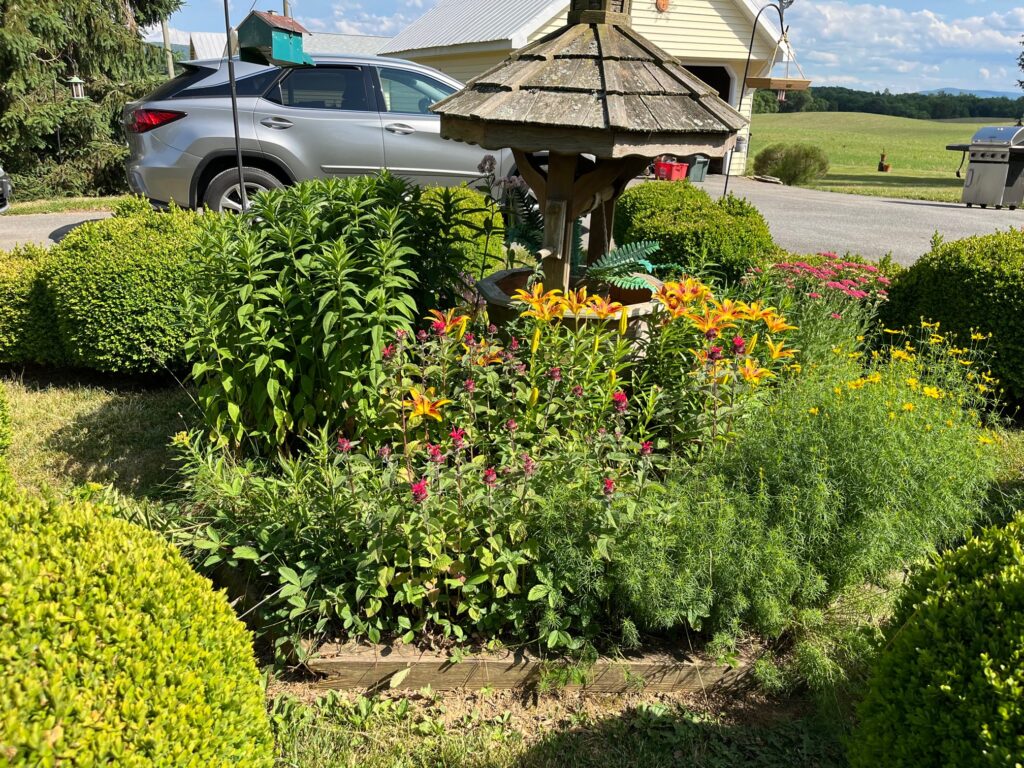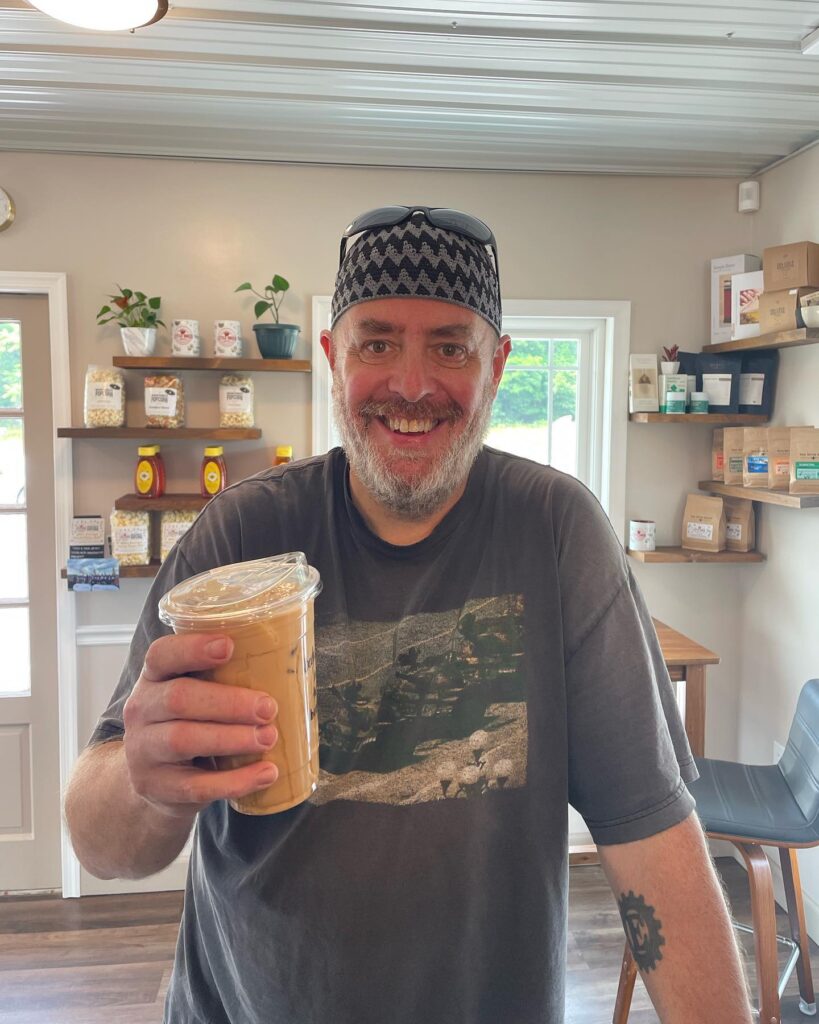Originally published in the Spirit of Jefferson, December 13, 2023

This summer around the county my neighbors and I have undergone a kind of Biblical plague of yellow jackets. They’ve always been around, but this year they took up residence under my front deck and in my rear wall. The frost finally did them in, but while I was still dodging them during the summer, I considered the options to get rid of them.
What got me concerned was whether the methods to use would also have a negative effect on the good bees, butterflies, and birds that together make up the necessary pollinators to keep our home and commercial vegetable and flower gardens around the county productive.
What troubled me was the news over the past few years that monarch butterflies were in serious decline and that honey bee colonies were collapsing all over the country. Too much pesticide or maybe too little pesticide or maybe bad timing of pesticide use?
One certain reason is that we humans are appropriating land that these insects need for habitat. This includes all the new housing tracts going in all over the county and the loss of our meadows to industrial uses or to agriculture that doesn’t actively benefit the pollinators.
In response to these concerns West Virginia set up an Apiary Division within the Department of Agriculture. The point of the Division, staffed by a State Apiarist, is to balance the interests of farmers and beekeepers to assure that crops and pollinators, especially honey bees, will thrive. It’s a matter of trying to control agricultural pests in a way that doesn’t harm pollinators, to minimize disease in bees, and to generally educate the population about how to be good neighbors with bees and butterflies. The details are laid out in the state’s Pollinator Protection Plan.
The Plan spells out how pollination is a critical part of plant reproduction, without it agriculture would fail entirely. Different plants pollinate in different ways, but flowering plants especially, have developed symbiotic relationships with insects to carry out the pollination. Fuzzy insects, like honey bees, feed on flower nectar and while doing so collect pollen on their bodies. Flying from one flower to another spreads the pollen and starts fertilization. Bees bring the nectar back to their hives and convert it into honey.
With this as preamble, what is the actual situation in Jefferson County. What are the ways in which the state’s Pollinator Protection Plan is carried out in the county? Are there in fact any substantial beekeeping and pollinator programs ongoing or planned?
The happy news is that there is a good deal of awareness and concern for protecting pollinators, even including organizations and individuals actively engaged in beekeeping and providing pollinator habitat. The less happy news is that there’s still a lot to do.
One of the most visible and active promoters of beekeeping in the county is Jason Murphy, owner of the Hive House Apiaries in Shepherdstown. Murphy is a beekeeper himself, but the Hive House is a venture dedicated to supporting other beekeepers, especially “newbees.” That term, by the way, is an inside joke with beekeepers who love to play off the word “bee.”
At the Hive House, Murphy sells his locally produced honey as well as beekeeping equipment. He also provides the training to get new beekeepers started, with the goal of sustaining their operation during and after the first year’s expensive labor and financial investment. He’s become something of a mentor, a role passed on to him by his own mentor.

This role of mentoring new beekeepers, Murphy says, is much needed because beekeeping requires attention, diligence, and skill, all of which develops over several years. Many aspiring beekeepers are disappointed when after a few years of trying their hoped-for return in homegrown honey doesn’t materialize. What happens instead is that they lose their hives, maybe because their bees ran out of food to sustain them over the winter, or they got overcrowded, or they fell victim to mites or other parasites, or they froze or overheated. It’s constant vigilance on the beekeeper’s part that assures success.
I was curious about how many beekeepers and hives there are in the county and what motivates people to want to raise bees. Talking with someone who’s been through all that and knows what to do is critical. Murphy says that in his experience bee hobbyists lose as many as 40 percent of their hives every year. With his more tenderly guarded hives, he’ll lose on average only one a year. In this last year’s crop that close attention paid off in about 4,000 pounds of honey from his hives.
Bees depend on pollen sources typically within a mile of their hive. But these sources have to be available more or less evenly throughout the foraging season, early spring to early fall. They have to be able to find available plant life to feed during each month, most critically during the mid to late summer when flowering plants are more sparse. When suitable plants are lacking, the bees have to be fed by their keepers instead.
The distribution of available natural food sources for bees is determined by how the local environment makes them available. This is why beekeepers as an important sideline have to be concerned with habitat and the preservation or expansion of habitat. This is something that doesn’t just concern bees. It’s a concern for all pollinators, some of which form specific relationships with specific plants. For instance the monarch butterfly, which is reaching endangered status, has a symbiotic relationship with milkweed. When milkweed levels decline, so do monarch levels, but milkweed not being a particularly desired decorative plant occurs naturally on land that’s being appropriated for industrial agriculture or housing.
So the strategy is to make milkweed a desirable planting where land is available. And here’s where gardeners and naturalists come into play. These individuals have a store of knowledge about how the local environment can be shaped and planted to support a diverse pollinator community, including bees, butterflies, moths, beetles, flies, bats, and birds.
For instance, the Potomac Valley Audubon Society (PVAS) operates two programs to build awareness of pollinator needs. One the Monarch Alliance is directly aimed at helping restore monarch butterfly levels in the Maryland, West Virginia, Virginia corridor. The Alliance has been most active in Washington County, MD, but there are fledgling efforts to actively expand into Jefferson County.
PVAS also operates the Protected Pollinator Patch program, which educates and certifies land owners, who have at least a half acre of unmowed meadow, on how to sow and maintain plants to attract pollinators. There are currently three homeowner properties that have enrolled in the program. Kristen Alexander, the director of PVAS, added that even if a homeowner wouldn’t qualify for the Pollinator Patch program, they can still benefit from the educational materials PVAS makes available on its website to guide landscaping and planting to support native wildlife.
More locally there is a developing intersection between beekeepers and master gardeners, who can sometimes be embodied in the same individual. One such person is Linda Layne in Harpers Ferry who has designed natural spaces on her own property to provide forage for her currently small hive operation. She is also the newly installed vice president of the Eastern Panhandle Beekeepers Association supporting almost 200 people interested in beekeeping. One of her first responsibilities will be to locally coordinate and host the next statewide West Virginia Beekeepers Association in Harpers Ferry in April, 2024.
Layne sees the club’s role to advance advocacy for beekeeping and habitat preservation by encouraging local communities (and potentially the county as a whole) to gain membership in the Bee City USA and Bee Campus USA initiatives.
These two programs encourage municipalities and schools to actively engage in setting up spaces to propagate native plants and pollinators, efforts which include turning public and private spaces into thriving conservation areas. In practice, creating and maintaining a healthy natural environment also includes developing pest management plans that discontinue or moderate the use of pesticides and building nesting sites for pollinators that balance out human and pollinator concerns,, say to “mow less and plant more.” Layne has petitioned the Town Council of Shepherdstown to submit an application for membership. This would be the first step in eventually extending the invitation to the entire county.
The success of efforts to educate homeowners about the advantages to pollinators and wildlife can be seen in PVAS’s work at the Cool Springs Reserve outside Charles Town. Here they have redesigned and replanted meadows as pollinator gardens. Within the relatively short span of 2 to 3 years, they have transformed something of a pollinator desert into a thriving pollinator oasis, creating an effective monarch waystation to support the butterfly’s annual migration.
Another monarch waystation is under development at the Rumsey Memorial park in Shepherdstown, an effort supported by a grant from the Monarch Alliance. The work of planning, designing, and scheduling the work was done through the general direction of the Shepherdstown Tree Commission.
So why all this effort to take care of our county’s insect life? Because without pollinators, especially bees, we don’t eat. West Virginia is still very much an agriculturally focused state and that extends to the Eastern Panhandle. Even in Jefferson County, according to County Commission data, we have more than 65,000 acres devoted to agriculture farmed by more than 600 operations, 96 percent family owned. And the number of farms is growing. There was a 21 percent increase in farms between 2012 and today. And the success of all these operations depends on pollination, the great majority by insects and especially bees.
Murphy, probably not exaggerating, says, “We keep bees so we don’t starve. Bees are the most important living things on the planet.” If so, then the extensive effort of so many people to care for our pollinators isn’t misplaced but likely still isn’t enough. It’s going to take others, maybe all of us, to do our bit.
Similar Posts:
- None Found